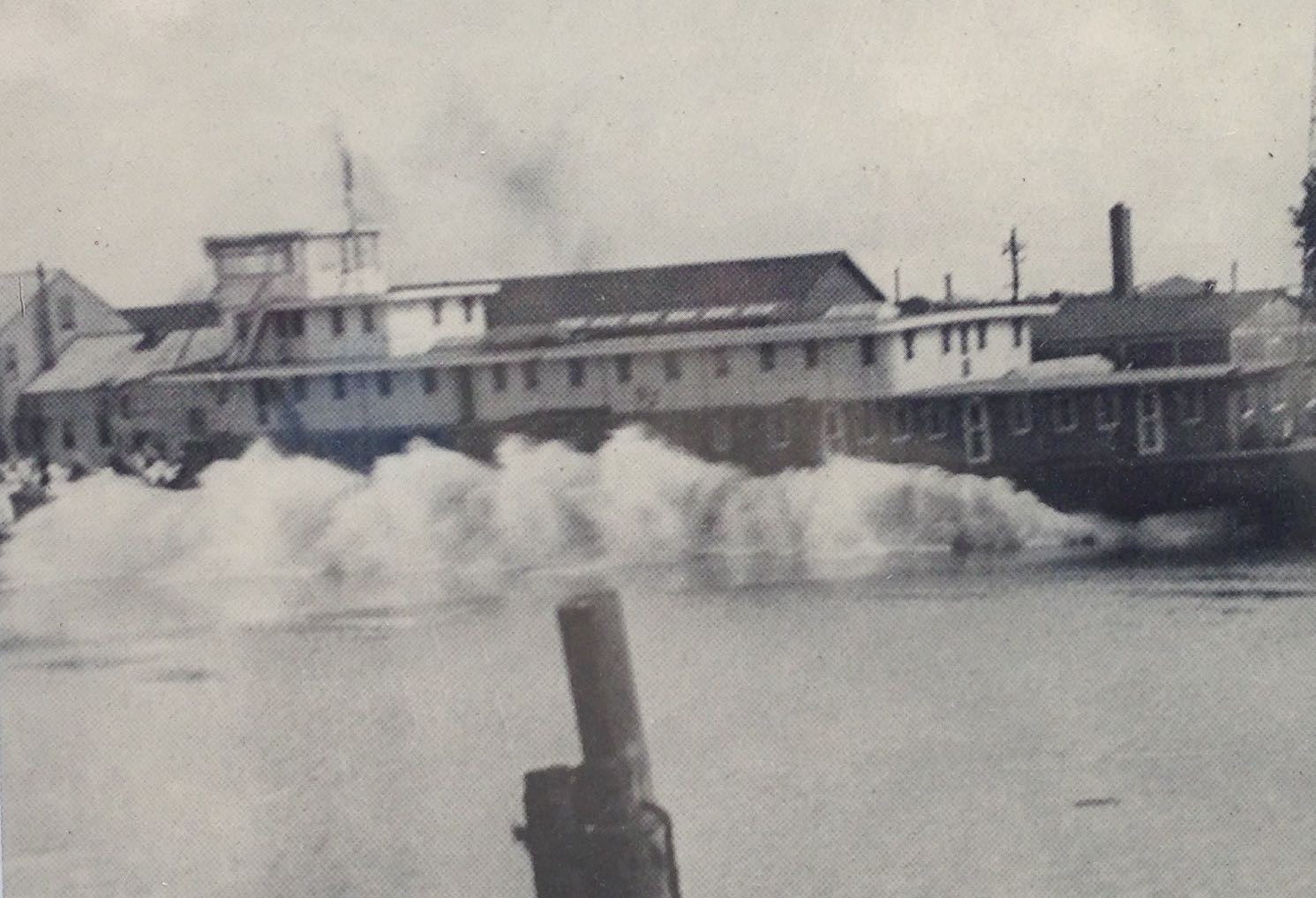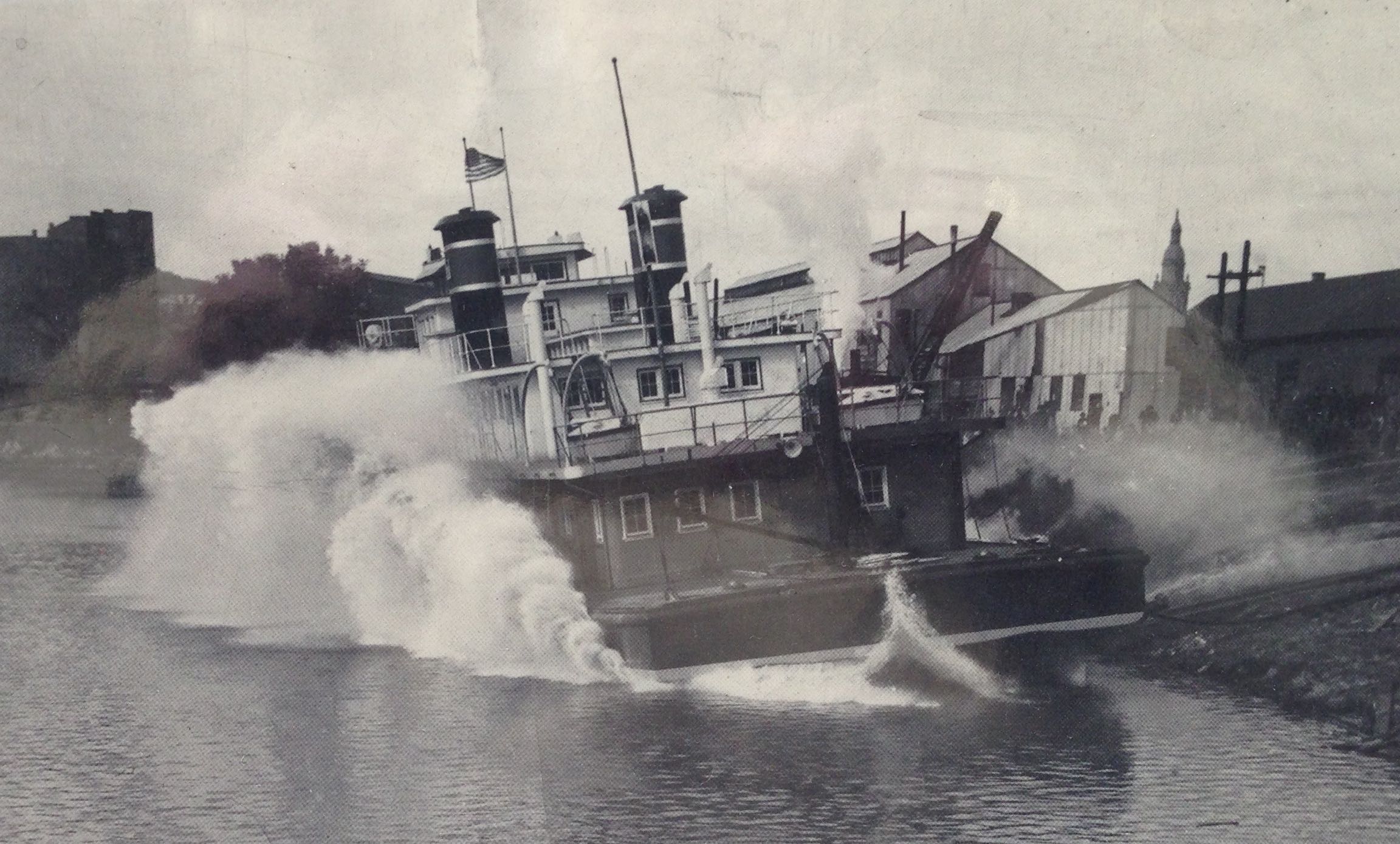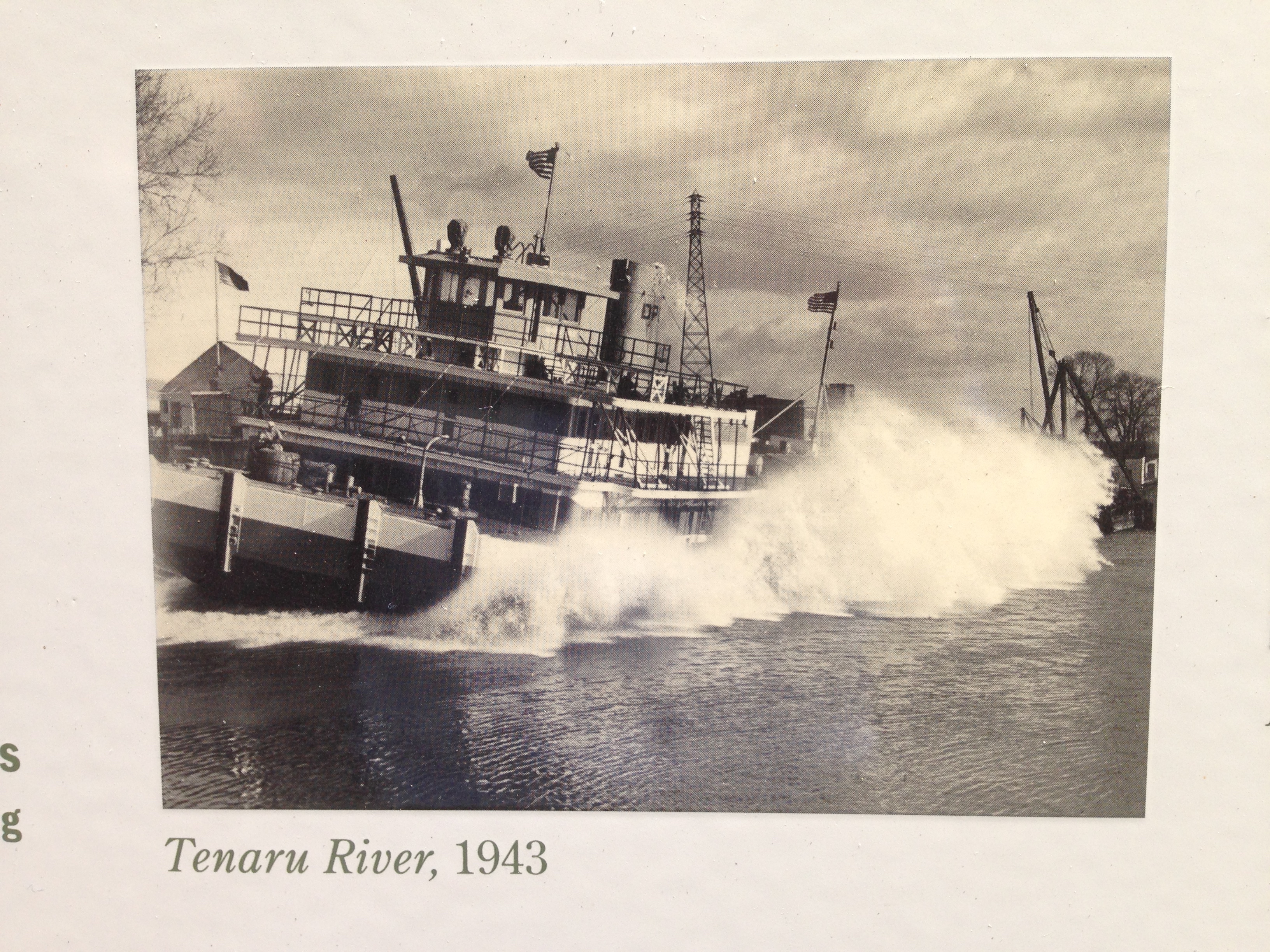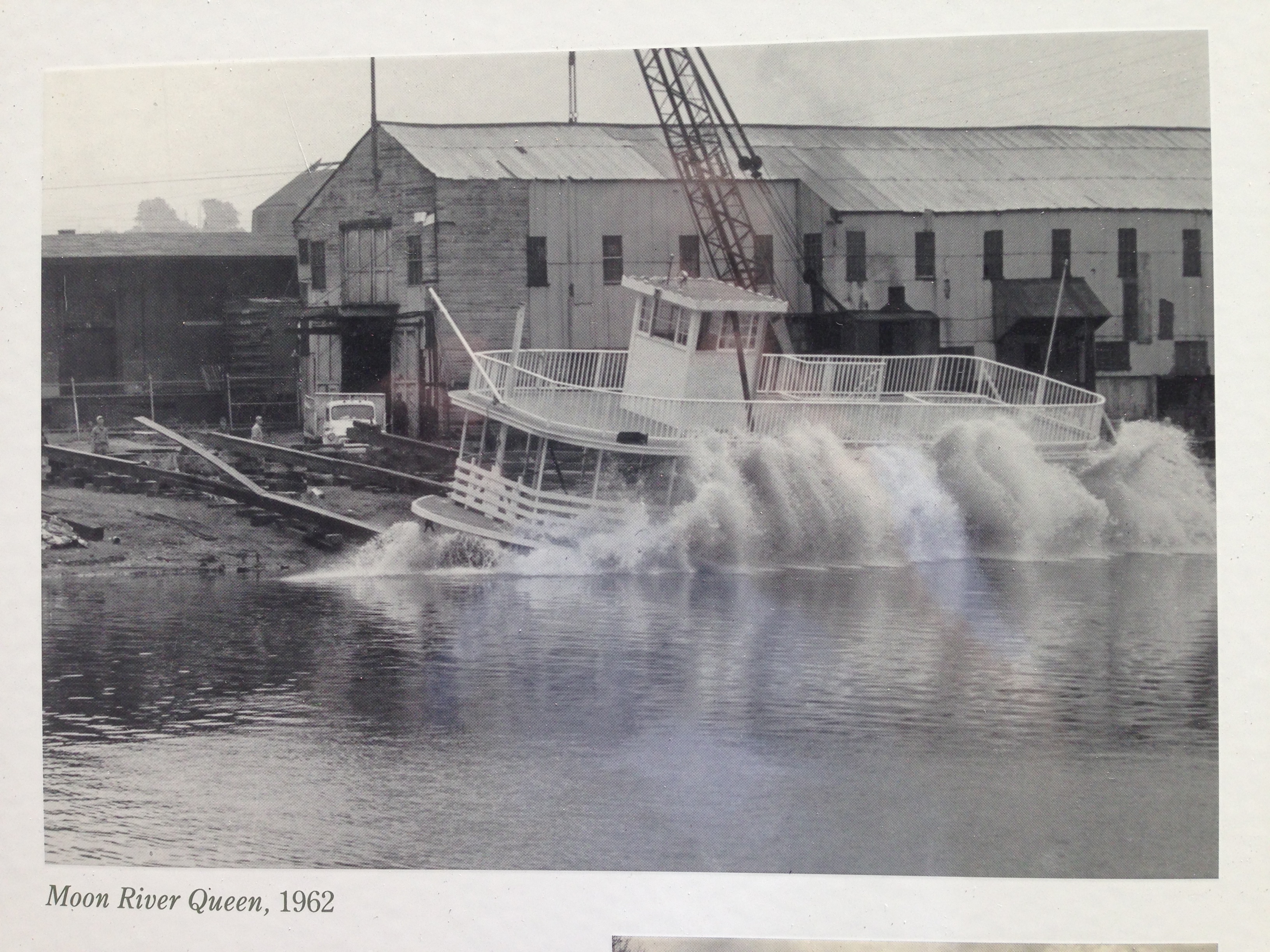Encyclopedia Dubuque
"Encyclopedia Dubuque is the online authority for all things Dubuque, written by the people who know the city best.”
Marshall Cohen—researcher and producer, CNN
Affiliated with the Local History Network of the State Historical Society of Iowa, and the Iowa Museum Association.
BOAT BUILDING: Difference between revisions
No edit summary |
No edit summary |
||
| (22 intermediate revisions by the same user not shown) | |||
| Line 1: | Line 1: | ||
[[Image:hoover1931.jpg|left|thumb|250px|Launching the Herbert Hoover, 1931. Photo courtesy: National Mississippi River Museum and Aquarium]] | |||
[[Image:delcommune37.jpg|left|thumb|250px|Launching the Del Commune, 1937. Photo courtesy: National Mississippi River Museum and Aquarium]] | |||
[[Image:tenaruriver.jpg|left|thumb|250px|Launching the Tenaru River, 1943. Photo courtesy: National Mississippi River Museum and Aquarium]] | |||
[[Image:moonriverqueen.jpg|left|thumb|250px|Launching the Moon River Queen 1962. Photo courtesy: National Mississippi River Museum and Aquarium]]BOAT BUILDING. One of the primary industries to develop in Dubuque, boat building really began after the [[CIVIL WAR]]. Prior to that, boats tended to be small and for local use. Larger boats were constructed along the Ohio River or the lower [[MISSISSIPPI RIVER]]. | |||
Beginning around 1870, boat building in Dubuque became a booming industry. On August 13, 1920 the "Frisco" became the ninety-ninth steamer constructed in the city. | |||
Most were constructed by the following: | |||
See: [[JOHNSON AND KALKE]] | |||
See: [[DIAMOND JO LINE]] | |||
See: [[IOWA IRON WORKS]] | |||
See: [[DUBUQUE BOAT AND BOILER WORKS]] | |||
'''Some of the boats were constructed by unknown builders. These include the:''' | |||
Jo Gales--a ferry boat between Dubuque and Dunleith owned and operated by Charles H. Merry. | |||
The Douglas Boardman--a passenger steamer with wooden hull built by W. J. Young | |||
The D. W. Hewitt--freight boat constructed in 1865 | |||
The Lansing--ferry from Dubuque to East Dubuque built by J. R. Graves, A. F. Jaeger, and J. Rhomberg | |||
The A. J. Dorchester--a freight boat constructed in 1869 by H. J. Reed | |||
The General Hyde Clark--a tow boat built in 1870 | |||
J. A. Rhomberg--Eagle Point ferry built by Fred Schreiner in 1870 | |||
Julia--built in 1871 as a passenger steamer with a wooden hull. | |||
The Fire Fly--built in 1875 as a tow boat by Laura E. Smith | |||
The Wineconne--a U. S. boat built in 1875 | |||
The James McMurchy--a ferry at Specht's Ferry built by Mrs. Specht in 1876 | |||
The Julia--built in 1876 as a tow boat | |||
The Key City--ferry to Dunleith built in 1876 | |||
The Delos--a U. S. boat built in 1881 | |||
The Fury--a U. S. boat built in 1881 | |||
The Wabash--built in 1881 as a passenger steamer | |||
The City of Winona--built in 1882 as a passenger steamer | |||
W. J. Young, Jr.--built in 1882 as a passenger steamer | |||
The George L. Bass--built in 1885 as a passenger steamer for P. Gilmartin and Henry Schroeder | |||
The Glenmont--built in 1885 by J. W. Van Sant | |||
The May Stewart--built in 1885 as a tow boat | |||
The Rose--built in 1886 as a passenger steamer | |||
The Lotus--built in 1886 as a tow boat | |||
The Jeanne Hopkins--built in 1887 by M. H. Moore | |||
The Reindeer---built in 1888 by the Mississippi Towing Company | |||
The Chester--built in 1888 | |||
The Jessie B.--built in 1891 by V. A. Bigelow as a passenger steamsr | |||
The Germania--built in 1892 as a passenger steamer | |||
The Lalla--built in 1893 as a passenger steamer | |||
The Quick Step--built by V. A. Bigelow in 1893 as a passenger steamer | |||
The Betsy Ann--built in 1899 as a passenger steamer | |||
The Lillian--built in 1891 as a passenger steamer | |||
The Zalus Davis--built in 1894 as a passenger steamer | |||
The Orian--built in 1894 by the Dillon Bros. as a passenger steamer | |||
The Quincy--built by L. G. Dolson in 1896 as a passenger steamer | |||
The Vulcan--a U. S. boat built in 1897 | |||
The Bob--built in 1905 as a tow boat | |||
The Ghost--built in 1903 as a pleasure boat | |||
The Frentress--built in 1903 as a passenger boat | |||
The J. R.--built in 1905 as a passenger boat | |||
The Eclipse--built in 1905 | |||
The Potosi--built in 1905 as a passenger steamer | |||
The Twilight--built in 1908 as a passenger boat | |||
See: [[DIAMOND JO BOATYARD]] | |||
--- | --- | ||
| Line 33: | Line 112: | ||
Source: | Source: | ||
1. | 1. "Dubuque, A Boat Building Centre," ''Telegraph Herald,'' August 21, 1910, p. 10 | ||
[[Category: Industry]] | [[Category: Industry]] | ||
Latest revision as of 01:44, 24 September 2019
BOAT BUILDING. One of the primary industries to develop in Dubuque, boat building really began after the CIVIL WAR. Prior to that, boats tended to be small and for local use. Larger boats were constructed along the Ohio River or the lower MISSISSIPPI RIVER.
Beginning around 1870, boat building in Dubuque became a booming industry. On August 13, 1920 the "Frisco" became the ninety-ninth steamer constructed in the city.
Most were constructed by the following:
See: JOHNSON AND KALKE
See: DIAMOND JO LINE
See: IOWA IRON WORKS
See: DUBUQUE BOAT AND BOILER WORKS
Some of the boats were constructed by unknown builders. These include the:
Jo Gales--a ferry boat between Dubuque and Dunleith owned and operated by Charles H. Merry.
The Douglas Boardman--a passenger steamer with wooden hull built by W. J. Young
The D. W. Hewitt--freight boat constructed in 1865
The Lansing--ferry from Dubuque to East Dubuque built by J. R. Graves, A. F. Jaeger, and J. Rhomberg
The A. J. Dorchester--a freight boat constructed in 1869 by H. J. Reed
The General Hyde Clark--a tow boat built in 1870
J. A. Rhomberg--Eagle Point ferry built by Fred Schreiner in 1870
Julia--built in 1871 as a passenger steamer with a wooden hull.
The Fire Fly--built in 1875 as a tow boat by Laura E. Smith
The Wineconne--a U. S. boat built in 1875
The James McMurchy--a ferry at Specht's Ferry built by Mrs. Specht in 1876
The Julia--built in 1876 as a tow boat
The Key City--ferry to Dunleith built in 1876
The Delos--a U. S. boat built in 1881
The Fury--a U. S. boat built in 1881
The Wabash--built in 1881 as a passenger steamer
The City of Winona--built in 1882 as a passenger steamer
W. J. Young, Jr.--built in 1882 as a passenger steamer
The George L. Bass--built in 1885 as a passenger steamer for P. Gilmartin and Henry Schroeder
The Glenmont--built in 1885 by J. W. Van Sant
The May Stewart--built in 1885 as a tow boat
The Rose--built in 1886 as a passenger steamer
The Lotus--built in 1886 as a tow boat
The Jeanne Hopkins--built in 1887 by M. H. Moore
The Reindeer---built in 1888 by the Mississippi Towing Company
The Chester--built in 1888
The Jessie B.--built in 1891 by V. A. Bigelow as a passenger steamsr
The Germania--built in 1892 as a passenger steamer
The Lalla--built in 1893 as a passenger steamer
The Quick Step--built by V. A. Bigelow in 1893 as a passenger steamer
The Betsy Ann--built in 1899 as a passenger steamer
The Lillian--built in 1891 as a passenger steamer
The Zalus Davis--built in 1894 as a passenger steamer
The Orian--built in 1894 by the Dillon Bros. as a passenger steamer
The Quincy--built by L. G. Dolson in 1896 as a passenger steamer
The Vulcan--a U. S. boat built in 1897
The Bob--built in 1905 as a tow boat
The Ghost--built in 1903 as a pleasure boat
The Frentress--built in 1903 as a passenger boat
The J. R.--built in 1905 as a passenger boat
The Eclipse--built in 1905
The Potosi--built in 1905 as a passenger steamer
The Twilight--built in 1908 as a passenger boat
See: DIAMOND JO BOATYARD
---
Source:
1. "Dubuque, A Boat Building Centre," Telegraph Herald, August 21, 1910, p. 10





